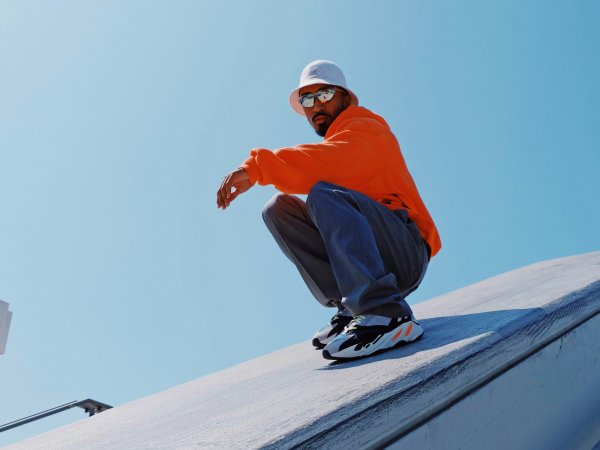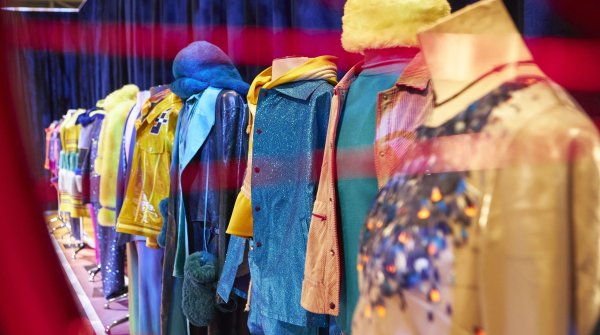The global hype surrounding functional it-pieces goes by the name of gorpcore - a neologism made up of the terms "normcore" and "gorp", the acronym for "good old raisins and peanuts", another term for the trail mix popular among hikers. Since New York Magazine first used the term in 2017, the trend has been growing and has been defining the looks of fashion-conscious Gen Z around the globe since the end of restrictions due to the coronavirus pandemic.
Trail runners from adidas TERREX, Salomon or On, chunky outerwear from Patagonia or The North Face, backpacks from Sandqvist, sunglasses from Oakley and hiking boots from Hanwag are no longer just running on trails and mountains, they are running through cities, through offices, across catwalks and, above all, through Tik Toks and Instagram stories. Even practical thermo mugs are experiencing a viral hype and are becoming fashion accessories, as the Stanley Cups prove. Gorpcore embodies the new lifestyle of Gen Z and Generation Alpha and is now considered the most enduring trend of the last 100 years.
According to McKinsey, sales of outdoor products rose by 24% in the year following the pandemic. This is not only influencing the fashion world, but is also changing the outdoor sector. Entering the fashion market definitely offers great opportunities and can already be very promising for outdoor start-ups. However, it is also clear that the fashion world has always been much more competitive, the sector is much larger and the target groups more difficult to reach. How can you still make it?
What does outdoor have that fashion doesn't? High-performance gear and sustainable innovation! High-tech textiles, functional cuts and environmentally friendly clothing are setting the trends of the moment and are more in demand than ever. No one satisfies this better than the outdoor and sports sector, because this is where the most exciting innovations are created, and they do so on their own initiative. On Running from Switzerland is the best example of this. In an interview for the ISPO series "Challenges of a CEO" last year, Caspar Coppetti talked about the shock when the management team realized that their cloud shoes were being worn by "architects on the streets of Zurich". At the time, the start-up was determined to avoid being perceived as a fashion brand. "We develop high-performance products for athletes and people who want to stay fit and healthy. Our success is based on our unique cloud technology, which we have spent years developing - at our core, we are an innovation company."
With this strategy, On has not only made it to the stock market, but has ultimately been able to make its way into architecture firms around the world. The high-performance shoes are among the most sought-after brands of the gorpcore movement and On now competes with industry giants such as Adidas and Nike thanks to the slogan "form follows function".
Many leading technologies originate from the outdoor segment. The fashion industry, for example, has long made use of textile developments such as Sympatex™, Nox™ or Polyola™ - all innovations from the outdoor industry. This gives them immense importance. It also works the other way around and is much less frowned upon than it was a few years ago. Why shouldn't the running shoe also come onto the market in a trendy neon look? At least at On, the design language has evolved considerably over the years and it seems as if Caspar Coppetti and his team are no longer so skeptical of the fashion world.
In addition to Gorpcore, the ongoing fashion trend Mountaincore is growing and a traditional Bavarian brand is one of the big winners in the new fashion game. Hanwag CEO Thomas Gröger ventured into the high-fashion segment with a colorful new edition of a classic shoe and reports on the surprisingly positive response from the scene in this ISPO article. "I've been in the outdoor business for more than 30 years now. In our industry, we have talked up and down about our history; 100 years of shoe craftsmanship and sustainable production in Europe. In the end, it was mostly all about the price. But that hardly plays a role in the high fashion segment. People are really interested in our story!"
This is just one of many examples that demonstrate the importance of the brand message. Patagonia and Ortovox take part in documentaries to highlight their concerns about environmental protection or climate justice. Outdoor brands have this educational aspect ahead of fashion brands: a connection to sport, to nature, to the environment, to healthy success. Real sustainability out of conviction instead of greenwashing and fast fashion. Those who concentrate on this and focus on their (digital) storytelling have a good chance of being well received by Gen Z.
Showing who you are, what you do and why: this message is becoming the be-all and end-all for all outdoor brands that want to position themselves in the fashion market. The industry is huge and waiting to be discovered is not very promising.
Of course, good social media marketing is a must for this endeavor - right where the target groups are: on TikTok and Instagram. If you want to get people talking, you have to deliver good content: your own brand story packaged in high-quality images and videos, told together with (fashion) influencers and distributed by sporty brand ambassadors with a wide reach.
However, there are also offline opportunities to enter the fashion market. In the case of Hanwag, a pop-up store at Paris Fashion Week was the breakthrough in the fashion segment. The retro red dot was sold out immediately. Other sportswear brands are also presenting new editions of their classics or innovative outdoor collections in the high fashion segment: at Fashion Weeks in Milan, Paris and Tokyo, on the catwalks of major luxury fashion brands or in their own showrooms - even during furniture fairs such as the Salone del Mobile in Milan.
If you are not at all familiar with the fashion world, you should look for good cooperation partners. Many fashion agencies are actively looking for outdoor brands to complement their range. They know what is important and where the trends are particularly in demand. And they have contacts with the big luxury brands, which are desperately looking for cooperation partners from the outdoor segment. In recent years, for example, New Balance x Ganni, Moncler x Adidas, On x Loewe, The North Face x Gucci, Jil Sander x Arc'teryx and Maison Margiela x Salomon have demonstrated this - at first glance perhaps unusual collaborations, which nevertheless mark some of the greatest successes of recent years - for both sides.
Alongside major luxury brands, athletes continue to be the most promising partners, as the sportswear megatrend is growing in parallel with the hype surrounding athletes. According to a forecast by PwC, the sports sponsorship market will grow to 109 billion US dollars by 2030. This is a huge market for both fashion and outdoor brands to reach new target groups. Many high fashion labels have already recognized this and are bringing athletes on board for advertising campaigns or equipping them with luxury products that are then seen millions of times on their social media channels.
The luxury group LVMH, which includes Christian Dior, Givenchy and Louis Vuitton, is a partner of the Olympic Games in Paris - a clever move that the outdoor industry can learn something from. Where do fashion trends originate? Who sets them? And where does your own brand message fit in?
If you keep asking these questions and answering them for your brand, you have a great chance of entering the fashion market and tapping into new, loyal target groups.
Gen Z loves micro-trends. They want to be special and stand out from the mainstream. Sneaker brands such as Veja or New Balance have been benefiting from this for years: Almost all of their limited-edition models have experienced unprecedented hype and are sold online for many times over.
This also explains the growing popularity of athletes and sporting events: Both mark snapshots, successes that are limited, take place in the now and can then no longer be repeated. The success factors are uniqueness and diversity. What does this mean for the outdoor industry, which aims to be the opposite of entertaining and is already successful in this respect? That the focus on genuine sustainability is the right way to go, because the fashionable concept of luxury is also defined by craftsmanship, unique items, high-tech innovation and - let's be honest - rarity. So anyone who makes themselves a little rare with limited edition collections is certainly well advised.
- Awards
- Mountain sports
- Bike
- Fitness
- Health
- ISPO Munich
- Running
- Brands
- Sustainability
- Olympia
- OutDoor
- Promotion
- Sports Business
- Textrends
- Triathlon
- Water sports
- Winter sports
- eSports
- SportsTech
- OutDoor by ISPO
- Heroes
- Transformation
- Sport Fashion
- Urban Culture
- Challenges of a CEO
- Trade fairs
- Sports
- Find the Balance
- Product reviews
- Newsletter Exclusive Area
- Magazine






